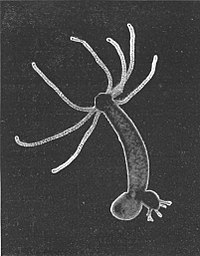
Photo from wikipedia
ABSTRACT Cellular senescence, an irreversible proliferative arrest, functions in tissue remodeling during development and is implicated in multiple aging‐associated diseases. While senescent cells often manifest an array of senescence‐associated phenotypes,… Click to show full abstract
ABSTRACT Cellular senescence, an irreversible proliferative arrest, functions in tissue remodeling during development and is implicated in multiple aging‐associated diseases. While senescent cells often manifest an array of senescence‐associated phenotypes, such as cell cycle arrest, altered heterochromatin architecture, reprogrammed metabolism and senescence‐associated secretory phenotype (SASP), the identification of senescence cells has been hindered by lack of specific and universal biomarkers. To systematically identify universal biomarkers of cellular senescence, we integrated multiple transcriptome data sets of senescent cells obtained through different in vitro manipulation modes as well as age‐related gene expression data of human tissues. Our analysis showed that RRAD (Ras‐related associated with diabetes) expression is up‐regulated in all the manipulation modes and increases with age in human skin and adipose tissues. The elevated RRAD expression was then confirmed in senescent human fibroblasts that were induced by Ras, H2O2, ionizing radiation, hydroxyurea, etoposide and replicative passage, respectively. Further functional study suggests that RRAD up‐regulation acts as a negative feedback mechanism to counter cellular senescence by reducing the level of reactive oxygen species. Finally, we found both p53 and NF‐&kgr;B bind to RRAD genomic regions and modulate RRAD transcription. This study established RRAD to be a biomarker as well as a novel negative regulator of cellular senescence. HighlightsPan‐senescence transcriptome analysis identified RRAD upregulation as a cellular senescence marker.RRAD functions to impede senescence by reducing reactive oxygen species levels.p53 and NF‐&kgr;B cooperatively upregulate RRAD expression in cellular senescence. Graphical abstract Figure. No Caption available.
Journal Title: Free Radical Biology and Medicine
Year Published: 2019
Link to full text (if available)
Share on Social Media: Sign Up to like & get
recommendations!